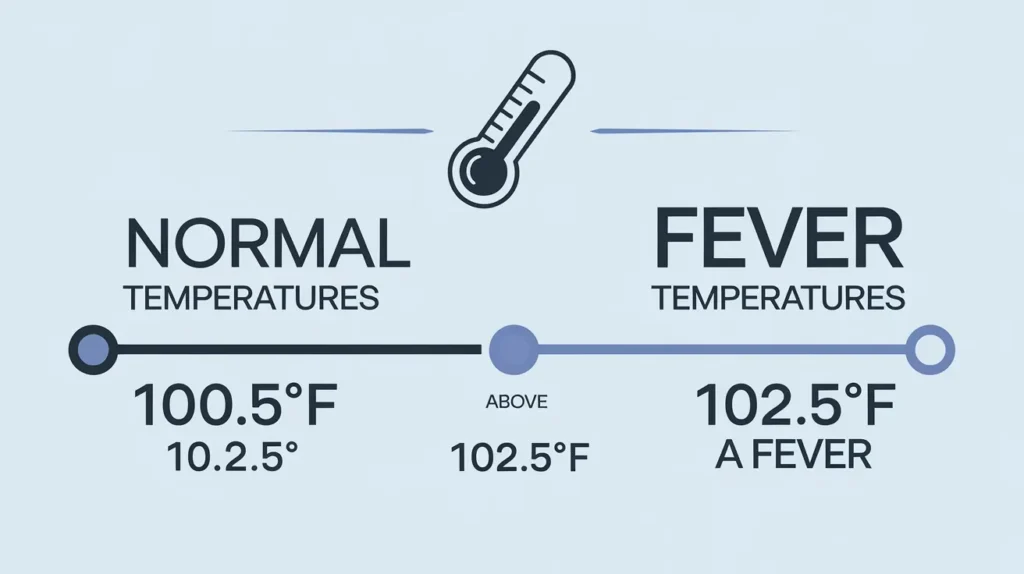As a dog owner, seeing your furry friend unwell can be distressing. One of the most common health issues dogs face is fever. Understanding what fever is, how to recognize its symptoms, and how to treat it at home can make a significant difference in your dog’s comfort and recovery. In this post, we will explore the symptoms of fever in dogs and offer helpful tips for home treatment.
Main Points of Post
What Is a Dog Fever?
A fever in dogs is often a sign that something is wrong. It’s not a disease itself but a symptom that indicates the body is fighting off infection or illness. A normal dog’s temperature ranges between 101°F to 102.5°F (38.3°C to 39.2°C). When the temperature rises above this range, your dog might have a fever.
Why Should You Care?
Imagine coming home to find your playful pup lethargic and unresponsive. It’s a heartbreaking sight. Knowing how to recognize fever symptoms in your dog could save you from unnecessary worry and help you take action quickly.
Common Symptoms of Fever in Dogs

When your dog has a fever, several symptoms may appear. Recognizing these symptoms early can help you take the right steps. Here are some common signs:
1. My Dog Feels Hot to Touch
One of the most straightforward ways to check if your dog has a fever is by feeling their ears or nose. If they feel warmer than usual, it might be a sign of a fever. However, remember that a warm nose doesn’t always indicate fever; some dogs naturally have warmer noses than others.
2. Lethargy and No Appetite
If your dog seems unusually tired and has lost interest in food, this can be a strong indicator of fever. Dogs are typically energetic and playful, so any significant change in their behavior is worth noting.
3. Shivering or Panting
If your dog is shivering or panting excessively, it may be trying to regulate its body temperature. This can happen even if the dog feels hot to the touch. Keeping an eye on these symptoms is crucial.
4. Red or Glassy Eyes
Fever can also cause changes in your dog’s eyes. If you notice redness or a glassy appearance, it could indicate that your dog is fighting an infection. This symptom often accompanies other fever signs.
5. Vomiting or Diarrhea
If your dog is experiencing gastrointestinal issues along with other fever symptoms, it’s important to consult a veterinarian. These signs could indicate a more severe underlying condition.
6. Dog Has Fever and Trouble Walking
If your dog seems to be having trouble walking or moving around, this could indicate more than just a fever. Joint pain or other issues may arise alongside fever, necessitating immediate veterinary attention.
Stay Alert!
Recognizing these symptoms early can help you decide whether your dog needs medical attention. If you notice multiple symptoms, don’t hesitate to reach out to your vet.
How to Tell if a Dog Has a Fever Without a Thermometer
If you don’t have a thermometer handy, there are a few other ways to gauge if your dog might have a fever:
- Feel Their Ears and Nose: As mentioned earlier, touching their ears and nose can provide insight into their temperature.
- Observe Behavior: If your dog is acting differently—less playful, more withdrawn—this could be a sign of fever.
- Check for Other Symptoms: Look for lethargy, changes in appetite, or vomiting.
Use Your Senses!
While these methods aren’t as accurate as using a thermometer, they can give you a good idea if your dog needs further attention.
Dog Fever Temperature

As mentioned, a normal dog’s temperature ranges from 101°F to 102.5°F. If you suspect your dog has a fever, aim to take their temperature accurately if possible. A fever generally starts at about 103°F (39.4°C) and can go higher.
Be Prepared!
Knowing your dog’s normal temperature can help you act quickly when they show signs of fever.
Dog Fever Treatment at Home
If your dog has a mild fever and shows no severe symptoms, there are several home treatments you can try. Always consult your vet before starting any treatment.
1. Hydration is Key
Make sure your dog has access to fresh water. Keeping them hydrated is crucial for recovery. Dehydration can worsen their condition.
2. Cool Cloths
You can use cool, damp cloths on their ears, paws, and the back of their neck. This can help lower their body temperature. Avoid ice-cold cloths, as this can shock their system.
3. Rest
Encourage your dog to rest. Providing a comfortable, quiet space for them can help in their recovery.
4. Monitor Symptoms
Keep a close watch on your dog’s symptoms. If their condition worsens or doesn’t improve within a day or two, it’s essential to contact your vet.
Hook: Simple Steps Matter!
These home treatments can often provide comfort and help your dog feel better.
Best Medicine for Dog Fever
If home treatments don’t seem to be working, you might wonder what medicines are safe for dogs. Never give your dog human medication without consulting your vet, as some can be toxic.
Over-the-Counter Options:
- Aspirin: In some cases, your vet might recommend low doses of aspirin for pain relief.
- Natural Remedies: Some natural supplements may help reduce inflammation and boost your dog’s immune system.
Safety First!
Always consult with your veterinarian before giving any medication. What works for humans might not be safe for dogs.
When to See the Vet
While many cases of fever can be treated at home, there are situations when you should see a veterinarian immediately. If your dog exhibits any of the following symptoms, don’t wait:
- Fever over 104°F (40°C)
- Persistent vomiting or diarrhea
- Trouble walking or severe lethargy
- Difficulty breathing
Don’t Wait!
If you have any doubts about your dog’s health, it’s always better to err on the side of caution.
Conclusion
Understanding the symptoms of fever in dogs is crucial for every dog owner. By being attentive to your dog’s behavior and knowing how to take action, you can help ensure they receive the care they need. Always remember to keep an eye on their temperature and watch for other concerning symptoms.
If your dog feels hot to touch, shows signs of lethargy, or has a reduced appetite, take the time to investigate further. And when in doubt, consulting a veterinarian is the best course of action. Your dog relies on you, and with the right knowledge, you can help keep them healthy and happy.
Be Your Dog’s Best Advocate!
By staying informed and attentive, you can be your dog’s best advocate in their health journey. Together, you can tackle any challenge that comes your way!



